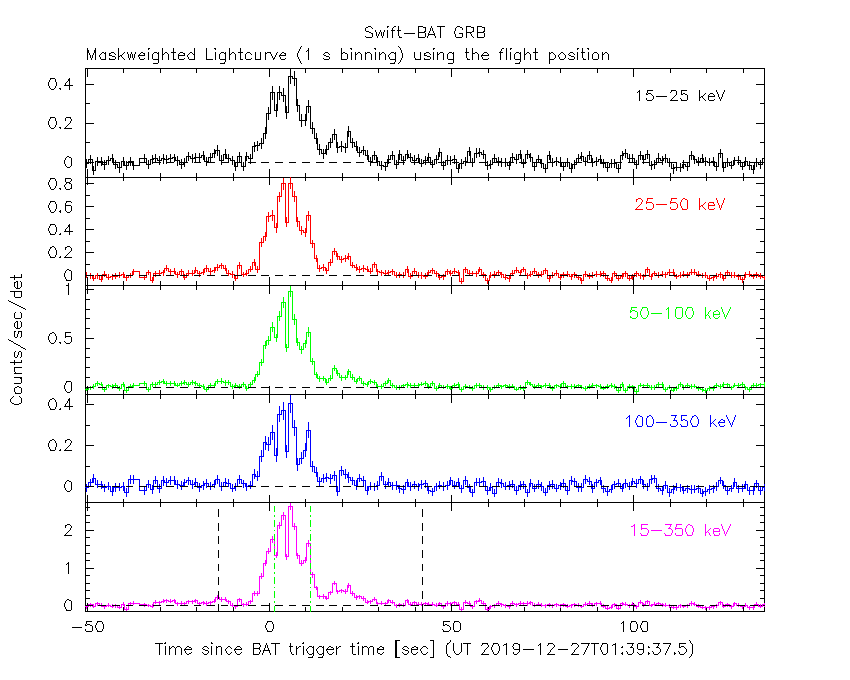
A. Melandri (INAF-OAB) for the Swift team
At 01:39:37 UT, the Swift Burst Alert Telescope (BAT) triggered and located GRB 191227A (trigger=946344) (Melandri et al. GCN Circ. 26595). Swift did not slew immediately due to an observing constraint. At the time of the trigger, the initial BAT position was 42° from the Sun (2.9 hours East) and 32° from the 1%-illuminated Moon. Table 1 contains the best reported positions from Swift.
Table 2 is a summary of GCN Circulars about this GRB from observatories other than Swift.
Standard analysis products for this burst are available at https://gcn.gsfc.nasa.gov/swift_gnd_ana.html.
As reported by Stamatikos et al. (GCN Circ. 26608),
the BAT ground-calculated position is RA, Dec = 319.172, -16.717 deg which is RA(J2000) = 2
The mask-weighted light curve (Figure 1) shows many overlapping pulses that starts from ~T-30 s and ends at ~T+105 s.
Several obvious peaks can be seen at ~
The time-averaged spectrum from T-30.55 to T+105.93 s is best fit by a simple power-law model.
The power law index of the time-averaged spectrum is 1.30 ± 0.05.
The fluence in the 15-150 keV band is 2.5 ± 0.1 x 1
The results of the batgrbproduct analysis are available at https://gcn.gsfc.nasa.gov/notices_s/946344/BA/.
XRT refined results are not available.
UVOT results are not available.

Figure 1. The BAT
mask-weighted light curve in the four individual and total
energy bands. The units are counts
| RA (J2000) | Dec (J2000) | Error | Note | Reference |
|---|---|---|---|---|
| 2 |
-16°43'02.5" | 1.2' | BAT-refined | Stamatikos et al. GCN Circ. 26608 |
| Band | Authors | GCN Circ. | Subject | Observatory | Notes |
|---|---|---|---|---|---|
| Optical | Lipunov et al. | 26594 | Swift GRB191227.07: Global MASTER-Net observations report |
MASTER | |
| Optical | Lipunov et al. | 26596 | Swift GRB191227A: Global MASTER-Net OT detection |
MASTER | detection |
| Optical | Adachi et al. | 26597 | MITSuME Akeno optical upper limits | MITSuME Akeno | upper limits |
| Gamma-ray | Fermi | 26593 | Fermi GBM Final Real-time Localization | Fermi GBM | |
| Gamma-ray | Dirirsa et al. | 26598 | Marginal detection by Fermi-LAT | Fermi LAT | |
| Gamma-ray | Poolakkil and Meegan | 26599 | Fermi GBM detection | Fermi GBM | Fluence=7.30±0.05x1 (96.9 percentile for long GRBs) |
| Gamma-ray | Svinkin et al. | 26614 | Konus-Wind observation | Konus-Wind | Duration=~52 seconds Fluence=1.02(-0.08,+0.09)x1 |
| Gamma-ray | Du et al. | 26618 | Insight-HXMT/HE observation | Insight-HXMT |
January 1, 2020